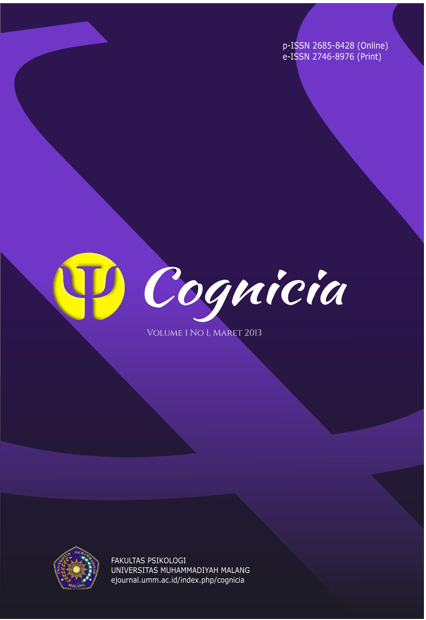SELF REGULATED LEARNING (SRL) DENGAN PRESTASI AKADEMIK SISWA AKSELERASI
DOI:
https://doi.org/10.22219/cognicia.v1i1.1455Abstract
Penelitian ini bertujuan untuk mengetahui hubungan antara Self Regulated Learning (SRL) dengan prestasi akademik siswa akselerasi. Penelitian ini menggunakan pendekatan kuatitatif korelasional dengan subjek sebanyak 52 siswa akselerasi kelas X yang tergabung dari tiga sekolah yakni SMAN 4, SMAN 5, dan SMAN 8 Kota X. Peneliti menggunakan skala likert yaitu Responden akan diminta untuk menyatakan kesetujuan atau ketidaksetujuan terhadap lima pernyataan dalam lima macam kategori. Untuk mengetahui prestasi akademik, peneliti menggunakan raport semester ganjil.Hasil pengujian korelasi menggunakan Korelasi Spearman dapat diketahui bahwa antara Self Regulated Learning (SRL) berkorelasi dengan Prestasi Akademik, karena nilai signifikansi dari Korelasi Spearman untuk SMAN 04 (sebesar 0,000), SMAN 05 (0,018) dan SMAN 08 (0,011) lebih kecil dari pada α (0,05). Korelasi yang didapatkan sebesar 0,823, 0,567, dan 0,615 yang keseluruhannya berkorelasi positif, artinya semakin tinggi skor Self Regulated Learning (SRL) maka Prestasi Akademik yang tinggi dan sebaliknya siswa dengan Self Regulated Learning (SRL) rendah memiliki Prestasi Akademik rendah.
Kata kunci : Self regulated learning (SRL), Prestasi akademik, Akselerasi
The aim of the research was to know the the correlation between Self Regulated Learning (SRL) with academic achievement for the accelerated students. The research used the correlational qualitative approach with 52 accelerated students on the tenth grade as the subjects. These students were merging from three schools which consist of SMAN 4, SMAN 5 and SMAN 8 in X city. For measuring the Self Regulated Learning (SRL), the researcher used Likert scale. In this way, the respondents are asked to make the agreement and disagreement for five statements in five categories. To know the academic achievement of students, the researcher used school report in odd semesters.The result of correlation test using Spearman correlation was known that Self Regulated Learning (SRL) was correlated with the academic achievement. The significance value from Spearman correlation of SMAN 04 was 0,000, SMAN 05 was 0,018 and SMAN 08 was 0,011 smaller than α (0,05). the whole of correlation was positive with value 0,823,0,567 and 0,615. It means, the higher score of Self Regulated Learning (SRL) the higher of the academic achievement. Just the opposite, the lower score of Self Regulated Learning (SRL) the lower of the academic achievement.
Keywords: Self Regulated Learning(SRL), Academic achievement, Acceleration
Downloads
Downloads
Published
How to Cite
Issue
Section
License
Copyright (c) 1970 Refista Befris Febrianela

This work is licensed under a Creative Commons Attribution-ShareAlike 4.0 International License.
Authors who publish with Jurnal Cognicia agree to the following terms:
- For all articles published in Jurnal Cognicia, copyright is retained by the authors. Authors give permission to the publisher to announce the work with conditions. When the manuscript is accepted for publication, the authors agree to automatic transfer of the publishing right to the publisher.
- Authors retain copyright and grant the journal right of first publication with the work simultaneously licensed under a Creative Commons Attribution-ShareAlike 4.0 International License that allows others to share the work with an acknowledgment of the work's authorship and initial publication in this journal.
- Authors are able to enter into separate, additional contractual arrangements for the non-exclusive distribution of the journal's published version of the work (e.g., post it to an institutional repository or publish it in a book), with an acknowledgment of its initial publication in this journal.
- Authors are permitted and encouraged to post their work online (e.g., in institutional repositories or on their website) prior to and during the submission process, as it can lead to productive exchanges, as well as earlier and greater citation of published wor (See The Effect of Open Access).

This work is licensed under a Creative Commons Attribution-ShareAlike 4.0 International License







